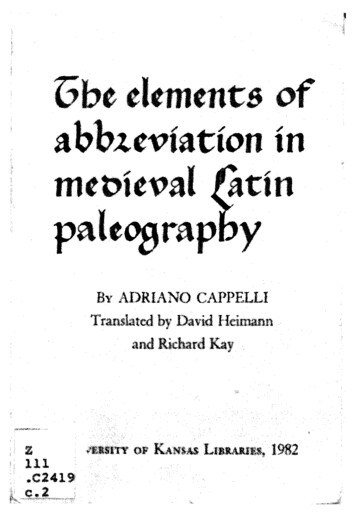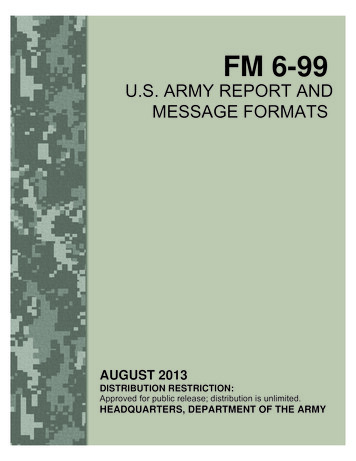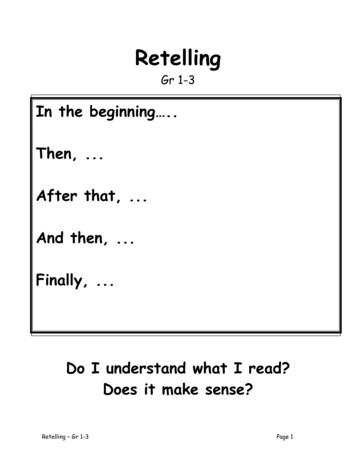
Transcription
The elements ofabbreviation inmedieval LatinpaleographyBY A D R I A N OCAPPELLITranslated by David Heimannand Richard KayUNIVERSITYOFKANSAS LIBRARIES,1982
University of Kansas PublicationsLibrary Series, 47
The elements ofabbreviation inmedieval LatinpaleographyBY ADRIANO CAPPELLITranslated by David Heimannand Richard KayUNIVERSITY OF KANSAS LIBRARIES, 1 9 8 2
Printed in Lawrence, Kansas, U.S.A.by the University of Kansas Printing Service
PREFACETake a foreign language, write it in an unfamiliar script,abbreviating every third word, and you have the compoundpuzzle that is the medieval Latin manuscript. For overtwo generations, paleographers have taken as their vademecum in the decipherment of this abbreviated Latin theLexicon abbreviaturarumcompiled by Adriano Cappelli forthe series "Manuali Hoepli" in 1899. The perennial valueof this work undoubtedly lies in the alphabetic list of some14,000 abbreviated forms that comprises the bulk of thework, but all too often the beginner slavishly looks up inthis dictionary every abbreviation he encounters, when innine cases out of ten he could ascertain the meaning byapplying a few simple rules. That he does not do so issimply a matter of practical convenience, for the entries inthe Lexicon are intelligible to all who read Latin, whilethe general principles of Latin abbreviation are less easilyaccessible for rapid consultation, at least for the Americanstudent. No doubt somewhere in his notes there is an out line of these rules derived from lectures or reading, buteven if the notes are at hand they are apt to be sketchy; forreference he would rather rely on the lengthier accountsavailable in manuals of paleography, but more often thannot he has only Cappelli's dictionary at his elbow. Thisi
does indeed devote forty-six introductory pages to "Brachigrafia Medioevale," but because this essay is in Italian,our Latinist almost invariably will consult it only as a lastresort after he has failed to find the form he seeks enteredin the L?xicon proper. Obviously, he could be spared mucheffort if the Lexicon were available in an English edition,as once it was in German, but since only the introductorypages require translation, it seems more practicable to issuethem separately as a supplement to the Italian edition cur rently in print, and its publisher, Dr. Ulrico Hoepli, hasgraciously consented.The purpose of this booklet is simply to make Cappelli'sprefatory treatise on the elements of Latin abbreviationavailable in English. It is intended as an aid to those whoare learning to transcribe Latin manuscripts, and for thislimited practical objective it should prove a satisfactoryguide, as it provides the beginner with an extensive description in English of the common abbreviatory practices ofmedieval Latin scribes. No doubt Cappelli's classificationof abbreviations was an imperfect system, overly rationalized,and as an historical statement of the development of Latinbrachygraphy it is largely antiquated, but neither defect im pairs its usefulness to one who wishes only to expand ab breviations correctly, since the principles remain true nomatter when or where they originated and however theyare presented.The present work, then, is a translation, complete andunabridged, of Adriano Cappelli's essay "Brachigrafia Medioevale" as it appears on pages xi-lvi of his Lexicon abbreviaturarum:Dizionario di abbreviaturelatine ed italianeusate nelle carte e codici specialmentedel medio-evo . . .ii
(3rd ed., Milan, 1929; lxxiii 531 pp.). The only innova tion is a decimal system of section numbers, which has beenadded for convenient reference.The Lexicon first appeared in 1899 as part of the series"Manuali Hoepli" and has since been revised four times,twice in Italian for the same series (1912, 1929) and twicein German for " J . J . Webers illustrierte HandbUcher"(Leipzig, 1901, 1928). A longer version of the Latin titlewas used in 1899—Lexicon abbreviaturarum quae in lapidibus, codicibus et chartis praesertim medii-aevioccurrunt—but all subsequent editions have reduced it to two words,following the example of the German ischer unditalienischerAbkurzungen.The first Italian edition contained 13,000entries, and although 3000 more were added in the Germantranslation of 1901, the next Italian edition was enlargedby only a thousand in 1912 to its present size of approximately 14,000 entries. Since 1929 no changes have beenintroduced into the Italian text, which continues to be re printed by the Casa Editrice Libraria Ulrico Hoepli, ViaU. Hoepli 5, Milano 20121.A valuable supplement based on Vatican manuscripts isalso available: August Pelzer, Abreviations latinesmedievales: Supplement au Dizionario di abbreviaturelatine editaliane de Adriano Cappelli (Louvain-Paris, 1964; vii 86pp.). Cappelli's French precursor has also reappeared infacsimile: L. A. Chassant, Dictionnairedesabreviationslatines et franchises usitees dans les inscriptionslapidaireset metalliques,les manuscrits et les chartes du Moyen a g e ,5th ed., Paris, 1884; reprinted by Olms (Hildesheim, 1965;lii 172 pp.).iii
The translators wish to thank James Helyar for the carewith which he edited this volume, and especially for his helpin restoring the penwork of the examples and for his callig raphy on the title page and cover.DAVID HEIMANNRICHARD KAYiv
0. INTRODUCTION0.1The medieval abbreviation system goes back to theancient Roman system of sigla, which are isolated lettersthat represent an entire word. It is also derived in partfrom the system of Tironian notes, a sort of shorthandthat in Roman times was employed primarily to recordpublic speeches. Considerable elements of both the siglasystem and that of Tironian notes survive in the widespreadmedieval abbreviation system that flourished, especially inItaly, from the 10th through the 15th centuries. This isthe system of medieval Latin abbreviation whose generalrules and principles we shall now examine.10.2All medieval abbreviations, for both Latin and Italianwords, can be divided into six categories, each of whichwill be treated in turn. Abbreviation can be indicated by:1. Truncation,2. Contraction,3. Abbreviation marks significant in themselves,4. Abbreviation marks significant in context,5. Superscript letters,6. Conventional signs.1. ABBREVIATION BY TRUNCATION1.1A word is abbreviated by truncation when only thefirst part of the word is actually written out, while an ab breviation mark replaces the missing final letters. Twokinds of marks are employed: (a) general signs, whichindicate simply that the word has been abbreviated withoutspecifying whether it has been truncated or contracted; and(b) specific truncation signs, which always indicate that1
some letters are lacking at the end of the word.1.2Both kinds of marks can have many forms; thefollowing are the most common:General signs:Truncation signs:1.3The general signs can all be written above a word,either as a separate character or in ligature with the longshafted letters. The last three, with closed loops, are usedespecially in papal bulls and royal charters.1.4The first truncation sign, a dot or period, is gen erally placed after the abbreviated word and is still in usetoday with the same meaning. Of the other signs, the firstthree are cross-strokes cut diagonally through the last letterof the abbreviated word, while the last three are tails thatform a ligature with the final letter. Although the next tothe last sign can be used to indicate simply the omission ofany final letter(s), it is used especially to indicate thedropping of the ending -is. The third sign from the lastis usually joined to the letter d to indicate the endings -dumand -dam, or the syllable dis. Some examples follow:2 salutem plurimam dicit mundio2
dixi autem denarii factis legitur dicendum concordantiis secundum numerati 3sumus omnis accipepertiche1.5Among the various abbreviations by truncation, thesigla are easily the most important. They are also the mostdifficult to interpret since they reproduce only the initialletter of the abbreviated word, Fortunately, it is generally3
only the most frequently used words and phrases that areso abbreviated. A few general rules will facilitate inter pretation.1.51It is generally the majuscule form of the initial letterthat is used, followed by a period. This practice is observedin both inscriptions and written documents. In the latter,however, we find minuscule letters are also used, neitherfollowed by a period nor separated by a space. For example:fq hq filius quondamhonesta foeminanqrq nunc quondam relicta quondam.1.511 Often, however, instead of a period such sigla aremarked by a general sign of abbreviation that is placedabove the siglum (§1.2-3).1.52Sigla which precede or follow proper names gen erally refer to position, title, or rank.J.C. D Juris consultusDux or DominusC.C.N.E.R. Causidicus Collegiatus Notarius Ecclesiae Romanae.1.53In medieval documents, and especially in juridicalusage, isolated sigla can refer to a proper name that beginswith the letter in question.1.54Not all medieval sigla are initial letters of the wordsthey represent. We find, for example: n i enimvel ergaaggirg igiturg ergoh nihil.ooctago, non supradictag ergo.o1.55Doubled sigla generally indicate the plural numberor the superlative degree, or sometimes also a word in which4
the letter in the abbreviation occurs two or more times.FF. GG ll. FratresGregoriuslegesLL libentissimePP Papapp propter.1.56Some sigla involve a tripled letter, especially ininscriptions, to indicate a group of three persons. A A A Augusti tres, D D D Domini tres, ggg germani tres.1.57Sigla are occasionally written upside down, backwards, or sideways in inscriptions, when they refer tofemale names or titles:or Mulier; Filia, Liberta; Tita; C a i a or Gaia. It must bepointed out, however, that the backward C ( ) is frequentlyused for the syllables con- or contra-, as in: Conlibertus;S C Contrascriptor; and Centurio.1.58In inscriptions, in order to distinguish sigla fromnumerals, a horizontal line is at times placed above thenumerals, thus:COS XIIII Consul decimusquartus1.581 Sometimes, however, the horizontal bar over thenumeral letter is used to increase the value by a factor of1000. Hence: quinquaginta milia; decem milia,etc.1.582 Even in inscriptions, however, the horizontal baroften serves simply to indicate an abbreviation. Thus: Christus; Militiae or Militum; Episcopus. These last examples cannot, strictly speaking, becalled sigla, since, in addition to the initial letter, they alsocontain other letters of the abbreviated word.5
1.6The decline of the sigla system in the 8th and 9thcenturies was marked by the appearance of less radicaltruncations which are much easier to interpret.AUG. Augustusin Ind anteINC BO.ME. Bonae Memoriae Not ob dat datum, dataeren dim dimidiumamaninde amenIndictioneIncipitNotarius-dom dominosigobligatiorenuntiandosigillo. 1.7The system of abbreviation by truncation, however,simple as it is, was not the most popular system in theMiddle Ages. In most cases, it was customary to furtherabbreviate truncated words by omitting one (or more) ofthe middle letters of the word. Thus Kal Kalendas isfurther abbreviated Kl. Similarly, quat quatenus becomesqt. Further examples:Dndl dr denariifl filius habet enimhbDominochartulanobilisMN minusms menseIncp Incipitmt montelb libbreqn quandonobisqr dilectissimieicarl NB NBL quare.1.8The conclusion of certain words abbreviated bytruncation is indicated by special signs of abbreviation, orby small letters written above the line at the end of theword, or by writing the end of the word itself but in ab6
breviated form. The first two methods will be discussedbelow (§ 3 and 5); for the third group, the following listillustrates some of the most common abbreviations of wordendings:.b .bis; nob nobis, urb urbis etc.c .cum, .cit; gc graecum, loc locum, fec fecit,dic dicit etc.d .dem, .dam, .dum; eed eaedem, q nd quondam,hnd habendum etc.I, .l' - .lis, .bilis; epal' episcopalis, 9util convertibilis etc.m .men, .mum; crim crimen, f'm firmum etc.n .nim, .nam; eten etenim, don donum etc.t .turn, .ter; act actum, similit similiter etc.u .vit, .um; c'au creavit, hndu habendum etc.x .xit; int dux introduxit, itellx intellexit.2. ABBREVIATION BY CONTRACTION2.1A word is abbreviated by contraction when one ormore of the middle letters are missing. Such an omission isindicated by one or the general signs of abbreviation ( § 1 . 2 ) .42.2Such abbreviations, according to Paoli, can be di vided into pure and mixed. They are pure when they pre serve the first and last letters of the contracted word, omittingall the middle letters. For example: oa omnia; pns praesens; dno domino; dia dimidia; epo episcopo;etc. They are called mixed if, in addition to the beginningand end of the word, they also preserve some of the middleletters. The result is actually two or more contractions inthe same word.7
pbr presbytermgro magistroKls— Kalendasmla multaMll Mediolanipnia poenitentiaoioops omnino omnipotensrelativumrimscdm prbrs vir secundumpresbyterisuniversaliter.2.3Among the pure contractions note especially thosewhich preserve only the initial and final letters of the con tracted word.ds nm oi nrDeusba beatanosternostrum, numerumdr diciturfnomnifit habetrotcratiomr mater, magisterce causaeci mm msptncoscivimatrimonium, meum forsan— tuncnl qrn nihilquoniamsecundum minus, menssm potestsr super nuncvr tn vester, videturtanturn omnestamenom omnemio ideotm na ss suisP r pater.natura2.4Contractions can occur either in the declined or inthe indeclinable parts of the abbreviated word.effctm effectum, snair sententialiter.8
2.41Most generally, however, the stem, or indeclinablepart, of the word is truncated and one or more of the firstletters of the word ending arc also dropped, often leavingonly the final letter. Word endings thus shortened are said tobe headless or acephalous, in distinction to truncated endings(§1.8).elm flselementumfalsustbi res rectussbe substantiaesubiecti.2.5The following two tables list the most common con tractions and truncations, first those involving the inde clinable stem of the word and next those affecting the wordending.2.51STEMS COMMONLY CONTRACTED OR TRUNCATED.acc. accus., accid.; accat accusat, accioi accusa-tioni, accns accidens, accnte accidente etc.ai. anim.; aie animae, aial ipl. apostol.; apis animal etc.apostolus, apllca apostolica etc.bn. bene., bon.; bnfm beneficium, bndnt bna benedicunt.bona, bnorum bonorum etc.cl. clausul.; clis co. commun.;elansuHs, oiam clausulam e t ccoem communem, coicatoi eommu-nicationi etc.dn. domin.; dnlce dl. dominice, dnacoi dominacioni etc.divisi.; d l i o divisioni, dis divisus, diom divi-sionem etc.din. divin.; dina divina, dini divini, dio divino e t c .dr. oder drn. differen.; dra differentia, drijs differentiis, drntie differentiae e t c .dr. divers.; drsa — diversa, drsimode diversimode etc.9
ee. esse.; eetis el. elemen.;essetis, eelr essentialiter etc.ela elementa,eltis elementis, elm elementum etc.ep. episcop.; epm episcopum, eps episcopus etc.epl. epistol.; epla epistola, eplis epistolis etc.exn. fc. existen.; exns existens, exnte fac.; fca facta, facto f a c t o5existente etc.etc.fl. fals.; flo falso, flm fr. fratr., frater; fribus fratribus, frs falsum etc.fratres, frna fraterna, frne fraternae etc.gl. glori.; glam gloriam, gloso glorioso etc.gn. gener.; gne genere, gnalis generalis etc.h. hab.; heo habeo, hitum habitum etc.hn. haben., habun.; hndi habendi, h n d a s h a b u n d a n s etc.hrd. hered.; hrds heredes, hrditar hereditario etc.ic. iamdict.; icti iamdicti, ictm iamdictum etc.ist. iamscript.; isto iamscripto, istis iamscriptis etc.ln. licen., liben., locumten.; lnia licentia, lnter olibenter, lns locumtenens.l r . . . litter.; lra littera, lre litterae etc.mgr. magistr.; mgro magistro, mgratum magistratum.mi. miseri., misericordi.; mia miseria, miam misericordiam, mir misericorditer etc.ml. mul.; mla multa, mlr mulier etc.mr. matr., mater.; mre matre, mrm matrimonium,mrona matrona, mrna materna etc.noi. nr. nomin.; noia nostr.; nra onomina, noiat nominatio etc.nostra, nrm nostrum etc.obn. obstan.; obste obstante, obntib obstantibus etc.o c c o — occasio; occoe occasione, occoalr occasionaliter etc.oi omni.; oia omnia, oino omnino, oim omnium etc.10
bmp. omnipoten.; omps omnipotens, ompis omni-potentis etc.on. osten.; ondo ostendo, onsio ostensio etc.pn. praesen., poeniten.; pns praesens, pna poenitentia.pp. praeposit.; pps praepositus, ppm praepositum etc.ppl. popul.; ppli populi, pplm populum, pplris po-pularis etc.pr. patr., pater.; pria patria, prs patris, prnus paternus etc.qn. quando., quan., quon.; qnq quandoque, qnt quantum, qnm quoniam etc.qo quaestio; qom quaestionem, qois quaestionis etc.rc. rec.; rca recta, rcm rectum, rcep receptioetc.rl. regul., rela.; rla regula, rlibus regularibus, rite relative, rlois relationis etc.rn. respon., renun.; rndit respondit, rnsum responosum, rens renuntians. rntijs renuntiis etc.ro. ratio; roe ratione, role rationale etc.sb. substan., subiect.; sba substantia, sbalis substantialis, sbiue subiective etc.sc. sanct.; scm sanctum, scuarij sanctuarii, selo sanctio etc.scd. secund.; scdm secundum, scds secundus etc.scl. saecul.; scla saecula, sclare saeculare etc.sg. signific.; sgans — significans, sgabit significabit etc.sil. simul., simil.; silatoe simulatione, sila similia,silr similiter etc.sl. singul., solut., saecul.; sloe solutione, slo solutio, slorum singulorum.sn. senten.; sna or snia sententia, snalr sententialiter, slaris saecularis etc.sp. speci., spirit; spali speciali, spair specialiter,11
spes species, spu spiritu, spitale spirituale,spual' spiritualis etc.sr super; srbi superbi, s r f i superficiale, sriri superiori etc.tp. temp.; tpla templa, tps tempus, tpra tempora.t r . . . termin.; tro termino, trm t e m i n u m , tros terminos etc.v r . . . vestr.; vrm vestrurn, vra vestra etc.x p . . . christ.; xpi Christi, xpofor Christoforus etc.le82.529ENDINGS COMMONLY CONTRACTED OR ACEPHALOUS.a .ta, .tia; rca recta, relca relicta, mla multa,dra differentia etc.blr .biliter; delcablr delectabiliter etc.br .biter; pbr presbyter etc.bs .bus; testibs testibus, hrdbs heredibus etc.co .cio, .ctio; ico inicio (initio), bndco benedictio etc.dt dunt; c'dt credunt, dnt dicunt etc.e .tiae, .me; sbe substantiae, plie plurime etc.is .tis; ompis omnipotentis etc.lr .liter, .lariter; talrlariter etc.lt (or tlr) taliter, pplr .libet; qmolt quomodolibetpopu-etc.m .nem, .em, .um; orom orationem, aalm salutem,frctm fructum etc.ns — .ens; accns accidens, hns habens etc.o .to, .tio; fco facto, rao ratio etc.oe .one ; dioe divisione, dispoe dispositione, colloe7 collatione etc.oi .oni; diloi dilationi, dioi divisioni etc.r .er,.ter,.tur,.ur; dnr dicuntur, dr dicitur, uidnr(or unr videntur, ppr propter etc.12
.rt .runt; fert ferunt, huert habuerunt, ert erunt.st .sunt; adst adsunt, posst possunt etc.s .us, .es, .is, .tus, .ens; fls falsus, frs fratres,prbrs presbyteris, dis divisus, rcs rectus, dics dicens, aspcs aspectus etc.t .it, .unt; incpt incipit, 9tigt contingunt, pett petunt, volt volunt etc.to .tio; tepto temptatio, mto mentio etc.tm .tum, ictm iamdictum, frctm fructum etc.3. ABBREVIATION MARKSSIGNIFICANT IN THEMSELVES3.0These are abbreviation marks that indicate whichelements of the abbreviated word are missing, no matterwhat letter the symbol is placed above or joined with as aligature. There are seven types: m, n con, com, cum, cun us, os, is, s3.1 r, r e , ra, ar ur, tur, er rum et, e.The first sign is a straight or slightly curved line,13
which we already know as a general abbreviation sign. Itis frequently used to indicate the omission of the lettersm or n:cod0 conditio, comue commune, i in.3.11This symbol was used throughout the Middle Ages,especially to indicate the omitted letter m in the endings -am,-em, -um.alia aliam, nobile nobilem, actu actum etc.3.12In the Visigothic script prior to the 9th century, aline with a dot over it ( — ) indicates the omission ofthe letter m, while a plain line ( — ) can indicate either acontraction or the letter n. But this distinction is not ob served in later Visigothic hands, for from the 9th centuryon, the line is always dotted, even when used as a generalmark of abbreviation.83.2The second symbol, which bears a strong resemblanceto the arabic numeral 9, and sometimes, especially in Gothichands, to the inverted letter C, is one of the oldest abbrevia tion symbols. It is to be found in the examples collectedby Valerius Probus and in the Tironian notes, always withthe meaning of con or cum. It was very popular in theMiddle Ages, and many words beginning with this symbolhave been collected in the Lexicon under the letter C. Thisis one of the few symbols that is invariably written on thesame line as the other letters, never above or below. Fre quently it stands alone, but is also used in conjunction withabbreviation signs or superscript letters.99cedc concedo149 contra
circumqir999 pleui complevi9 g n i t i o congnitio109ctis9tis9*999aa cunctis cunctisi9 condam (quondam) contra conceptus— contraria communi.3.3The third symbol can resemble the preceding one,but often it has instead the form of an outsize comma.Whatever the form, it almost always can be recognized byits distinctive position, since with only rare exceptions it iswritten above the line and at the end of a word. Generallyit stands for the ending -us; but it can also be used for os,-is, or simply s.pri99su9Pid99i t9 priussuuspostnob9fi9iun9 idus iustus9 nobisfiliusius nos.113.31 Wattenbach lists as other meanings for the symbol9 the combinations et and ue. E.g. q9 que; man9 manet;s9 -set (sed). There are, however, very few instances ofthis apart from the common sign s9 for set; this is probablyto be explained as a corruption of the 7-mark (s7 set;cf. §3.7).123.32A sign very similar to the -us was occasionallyplaced above certain consonants to mark the omission ofer, but never at the end of a word. sincerum revertitur.15
But since this is not actually a symbol for -us, we shall treatit more fully in §4.31.3.4The fourth symbol, which consists simply of a wavyline, sometimes very pronounced, almost like the letter u,is written above a word to indicate the omission of theletter r or a syllable which contains an r, such as re, ra, ar.corige corrigere, pete petere.3.41 In many cases, however, this wavy line is used toindicate the letter a or a syllable that ends with a. nota puta.The symbol is, in this case, simply a transformation of theletter a, which about the 13th century came to be confusedwith the characteristic symbol for r. Down to the end ofthe 15th century, the two symbols are almost indistinguish able. Examples of this are to be found in the words:i ita, infra; pp papa; morlr mortaliter.3.42In manuscripts of the 14th and 15th centuries, espe cially those written in Gothic script, this wavy line developsfurther into a broken horizontal bar, or two heavy dotsclosely spaced.No Nota, qle quale, sop sopra.3.5The fifth sign, resembling an arabic numeral 2 oran S lying on its side ( ) , was extensively used in mostmedieval hands to indicate an omitted ur or tur, generally16
at the end of a word and almost always written above theline. On rare occasions it can also stand for the syllabicer or ter, but not at the end of a word.2gs2tenet teneturdic diciturc2rit currit22 generis materialcet o caetero.ma s23.6The sixth sign is somewhat similar to the fifth. Italso resembles an arabic 2, but with an oblique line throughthe tail. Almost always on the line and at the end of theword, most commonly it is used to indicate the syllable-rum. Note that since the oblique line is also a sign oftruncation, this sign can further stand for any final syllablethat begins with an r (see §1-4). illorum coram notarius feria.3.7The seventh sign, similar to the arabic numeral 7and standing for et or e, is used both independently as aconjunction and also in the composition of larger words.This is true also of the ampersand (&), a form which ispopular even today.133.71With the addition of a horizontal bar above the char acter, either form stands for etiam or, when it occurs atthe end of a word, -ent.17
etiam agent edicti aeternum.3.72In its 7-shape, this sign is sometimes used for theenclitic -que; e.g., at7 atque. Less frequently this standsfor -us, especially after the letter b in the final syllable:quib7 quibus. Most likely this form is a corruption ofthe symbol 9, standing for -us, written, as it sometimes was,on the line rather than above. As a matter of fact, we alsofind the word quibus abbreviated quib9.3.8Many other peculiar signs were used during theMiddle Ages to express the conjunction et: they are listedin the Lexicon together with the other conventional signs.4. ABBREVIATION MARKSSIGNIFICANT IN CONTEXT4.0Among the abbreviation signs that indicate whichelements are missing in the abbreviated word, there aresome whose meaning is not set and constant but variesrelative to the letter with which the sign stands. These signsare:18
4.1Here again the first sign is a straight line. Its mean ing depends on the context. As has already been said, itcan be a mark of abbreviation in general (§1.3) or can sig nal the omission of m or n (§3.1). The same line assumesdifferent meanings when it cuts across the shaft of theletters d, h, or l, and when it is written above the lettersp and q or cuts across the tails of these letters. bre., ber., .ub cum, con, cen. condam de., der., .ud haec, hoc, her. vel, ul., .el men., non, nun.(quondam)mtm. obiit per, par., por.19
14 prae, pre. propter, qui quae quoque quam ter., tern., ten. ven., ver.papa151 64.2The period, the colon, the semicolon, and the marklike an arabic 3 are used almost always at the end of a word,and are written on rather than above the line.4.21 When these signs follow the letter b (b. b: b ;b3) they all can stand for -us; the last two can also standfor -et.4.22 When they follow the letter q, they stand for -ue(forming the enclitic -que), although the 3-mark, and some times the semicolon, can stand alone for the enclitic -que.4.23 The semicolon following the letter s is frequendyfound in 12th-century Lombard charters for -is at the endof a word (-s; -sis).20
4.24In 14th-century hands the 3-mark stands for est,either independently as the copulative verb, or at the end ofa word, such as: prod3 prodest; it'3 interest.4.25A dot or period written above h stands for hoc;above « the point signifies ut.4.26These examples illustrate §4.21 ff.quib;omnib.quod;quilib:q 93nhab3uaq3 quibusomnibusquodquequilibetquacumquehabetusque usque17usq;ms; riss3 remissiscas;h uaumensiscasishocut, utiaut.4.27In bookhands of the 8th and 9th centuries, the signq; is generally augmented by a point (q;») whenever itstands for quae, either independently or as a component ofa larger word. This distinguishes it from the enclitic -queq; q;4.28 quaeque, q: 80 quaeso18The following contractions deserve special attention. t3 n3d h3 in 3 03tuit3 V33videlicet, valettenetneque, necdebethabetinestoportetoportuitP3 19patetlicet; butas suffix.libet, c l3cuiuslibet set (sed) cumque. l39s933 21
4.281 When the 3-mark occurs at the end of a word andis preceded by the vowel a, e, or u, it generally does notstand for -us or -et, but rather for m. It is almost alwayswritten on the same line as the other letters in the word,for example: na3 nam; oe3 omnem; hitu3 habitum.In the Lombardic script, however, it is more frequentlywritten above the line, not only at the end but in the middleof the word as well.204.282 The same sign following the vowel o is often usedfor the final syllable -nem, as in opio3 opinionem.21224.283 In a Roman charter of the year 1177, we find the3-mark with its tail cut by an oblique line, standing for thesyllable -rum, as in: ypotecarurn romanorurn.4.2831 In Lombard charters of the 11th century, the end ing -orum is expressed thus:4.29 Two periods positioned on either side of an isolatedletter have the following meanings:4.322 e est s scilicet i n id est t tunc enim q quasi 9 condam 7 — etiam.(quondam)The third sign is simply an oblique line, frequently
hooked at one or both ends, cutting transversely across al most any letter of the alphabet, and assuming a variety ofdifferent meanings. Most of the time it indicates the omis sion of the syllables er, ar, or re.4.31This sign was often replaced
the system of medieval Latin abbreviation whose general rules and principles we shall now examine. 0.2 All medieval abbreviations, for both Latin and Italian words, can be divided into six categories, each of which will be treated in turn. Abbreviation can be indicated by: 1. Truncation,










